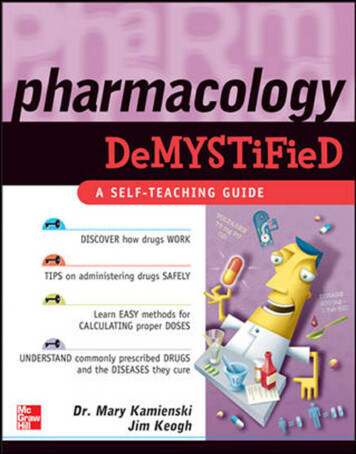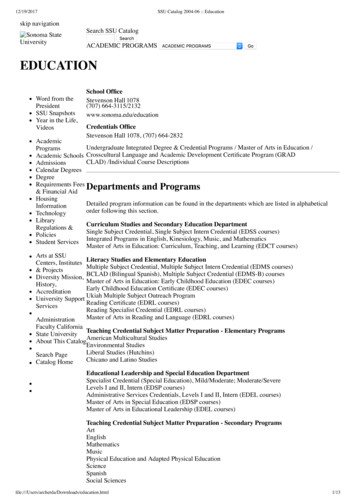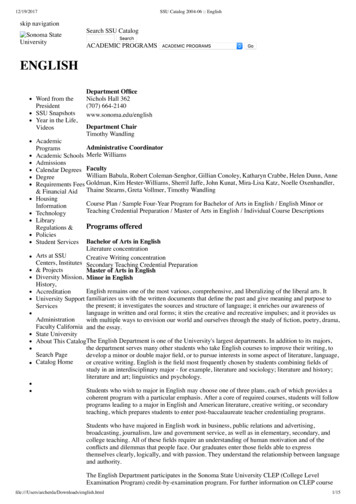
Transcription
PHARMACOLOGY DEMYSTIFIED
Demystified SeriesAdvanced Statistics DemystifiedAlgebra DemystifiedAnatomy Demystifiedasp.net DemystifiedAstronomy DemystifiedBiology DemystifiedBusiness Calculus DemystifiedBusiness Statistics DemystifiedC DemystifiedCalculus DemystifiedChemistry DemystifiedCollege Algebra DemystifiedData Structures DemystifiedDatabases DemystifiedDifferential Equations DemystifiedDigital Electronics DemystifiedEarth Science DemystifiedElectricity DemystifiedElectronics DemystifiedEnvironmental Science DemystifiedEveryday Math DemystifiedGenetics DemystifiedGeometry DemystifiedHome Networking DemystifiedInvesting DemystifiedJava DemystifiedJavaScript DemystifiedLinear Algebra DemystifiedMacroeconomics DemystifiedMath Proofs DemystifiedMath Word Problems DemystifiedMedical Terminology DemystifiedMeteorology DemystifiedMicrobiology DemystifiedOOP DemystifiedOptions DemystifiedOrganic Chemistry DemystifiedPersonal Computing DemystifiedPharmacology DemystifiedPhysics DemystifiedPhysiology DemystifiedPre-Algebra DemystifiedPrecalculus DemystifiedProbability DemystifiedProject Management DemystifiedQuality Management DemystifiedQuantum Mechanics DemystifiedRelativity DemystifiedRobotics DemystifiedSix Sigma Demystifiedsql DemystifiedStatistics DemystifiedTrigonometry Demystifieduml DemystifiedVisual Basic 2005 DemystifiedVisual C# 2005 Demystifiedxml Demystified
PHARMACOLOGY DEMYSTIFIEDMARY KAMIENSKI,PhD, RN, FAEN, FNP, CENJIM KEOGHMcGRAW-HILLNew York Chicago San Francisco Lisbon LondonMadrid Mexico City Milan New Delhi San JuanSeoul Singapore Sydney Toronto
Copyright 2006 by The McGraw-Hill Companies, Inc. All rights reserved. Manufactured in the United States ofAmerica. Except as permitted under the United States Copyright Act of 1976, no part of this publication may be reproduced or distributed in any form or by any means, or stored in a database or retrieval system, without the prior written permission of the publisher.0-07-148344-6The material in this eBook also appears in the print version of this title: 0-07-146208-2.All trademarks are trademarks of their respective owners. Rather than put a trademark symbol after every occurrence of atrademarked name, we use names in an editorial fashion only, and to the benefit of the trademark owner, with no intentionof infringement of the trademark. Where such designations appear in this book, they have been printed with initial caps.McGraw-Hill eBooks are available at special quantity discounts to use as premiums and sales promotions, or for use incorporate training programs. For more information, please contact George Hoare, Special Sales, at george hoare@mcgrawhill.com or (212) 904-4069.TERMS OF USEThis is a copyrighted work and The McGraw-Hill Companies, Inc. (“McGraw-Hill”) and its licensors reserve all rights inand to the work. Use of this work is subject to these terms. Except as permitted under the Copyright Act of 1976 and theright to store and retrieve one copy of the work, you may not decompile, disassemble, reverse engineer, reproduce, modify,create derivative works based upon, transmit, distribute, disseminate, sell, publish or sublicense the work or any part of itwithout McGraw-Hill’s prior consent. You may use the work for your own noncommercial and personal use; any other useof the work is strictly prohibited. Your right to use the work may be terminated if you fail to comply with these terms.THE WORK IS PROVIDED “AS IS.” McGRAW-HILL AND ITS LICENSORS MAKE NO GUARANTEES OR WARRANTIES AS TO THE ACCURACY, ADEQUACY OR COMPLETENESS OF OR RESULTS TO BE OBTAINED FROMUSING THE WORK, INCLUDING ANY INFORMATION THAT CAN BE ACCESSED THROUGH THE WORK VIAHYPERLINK OR OTHERWISE, AND EXPRESSLY DISCLAIM ANY WARRANTY, EXPRESS OR IMPLIED,INCLUDING BUT NOT LIMITED TO IMPLIED WARRANTIES OF MERCHANTABILITY OR FITNESS FOR APARTICULAR PURPOSE. McGraw-Hill and its licensors do not warrant or guarantee that the functions contained in thework will meet your requirements or that its operation will be uninterrupted or error free. Neither McGraw-Hill nor itslicensors shall be liable to you or anyone else for any inaccuracy, error or omission, regardless of cause, in the work or forany damages resulting therefrom. McGraw-Hill has no responsibility for the content of any information accessed throughthe work. Under no circumstances shall McGraw-Hill and/or its licensors be liable for any indirect, incidental, special,punitive, consequential or similar damages that result from the use of or inability to use the work, even if any of them hasbeen advised of the possibility of such damages. This limitation of liability shall apply to any claim or cause whatsoeverwhether such claim or cause arises in contract, tort or otherwise.DOI: 10.1036/0071462082
ProfessionalWant to learn more?We hope you enjoy thisMcGraw-Hill eBook! Ifyou’d like more information about this book,its author, or related books and websites,please click here.
For more information about this title, click hereCONTENTSIntroductionxiiiCHAPTER 1An Inside Look at PharmacologyWhat Is Pharmacology?The Source of DrugsDrugs NamesPrescription versus Over-the-Counter DrugsDrug EffectsDrug SafetyLocating Drug InformationDrug OrdersThe “Five Rights” Way of Drug AdministrationSummaryQuiz12467781112162021CHAPTER 2Drug Action and Drug InteractionsDrug ActionsThe First Pass EffectPharmacodynamicsCategories of Drug ActionTherapeutic Index and Therapeutic RangeSide EffectsSummaryQuiz232433333535363839v
viCONTENTSCHAPTER 3CHAPTER 4CHAPTER 5Pharmacology and the Nursing ProcessThe Nursing ProcessNursing DiagnosisPatient Care PlanTeaching the Patient About DrugsImpact of Cultural Influences inDrug AdministrationMother and the ce AbuseDrug Misuse and AbuseBehavioral Patterns of AddictionHealthcare Professionals andSubstance AbuseDetecting Substance AbuseDelayed ActionSubstances That Can Be AbusedDependence versus TolerancePathophysiologic Changes Occurring inSubstance AbuseCultural Aspects of Substance AbuseCommonly Abused SubstancesNursing AssessmentSummaryQuiz616163Principles of Medication AdministrationThe Nursing Process andMedication 82
viiCONTENTSAssessment Required for Specific DrugsAdministering MedicationEvaluating the Patient AfterAdministering MedicationControlling NarcoticsSummaryQuiz848792939494CHAPTER 6Route of AdministrationMedication and RoutesZ-Track Injection TechniqueTips for Minimizing PainSummaryQuiz9797107109110111CHAPTER 7Dose CalculationsThe Metric System and MedicationConverting Metric UnitsFormulas for Calculating the Desired DoseParenteral MedicationsSummaryQuiz113113116117119121122CHAPTER 8Herbal TherapyInside Herbal TherapyForms of Herbal TherapiesHazards of Herbal TherapeuticsHerbals Therapy and the Nursing ProcessThe Do’s and Don’ts about HerbsCommonly Used HerbsSummaryQuiz125125127128129130131135135
viiiCONTENTSCHAPTER 9Vitamins and MineralsVitaminsVitamins and the Nursing ProcessSummaryQuiz137137148154154CHAPTER 10Fluid and Electrolyte TherapyBody FluidsElectrolytesFluid ConcentrationIV FluidsBlood and Blood ProductsFluid HAPTER 11Nutritional Support TherapiesNutritionNursing ProcessThe Nursing Processing andParenteral Nutritional TherapySummaryQuiz183183189CHAPTER 12InflammationAn Inside Look at InflammationCombating InflammationSummaryQuiz197197199201201CHAPTER 13Antimicrobials—Fighting InfectionMicroorganisms—A Small FormidableOpponentMedication—A Formidable Defender203192193194204204
ixCONTENTSSuperinfectionsPreparing to AdministerAntimicrobial MedicationPenicillin, Nursing Diagnosis,and Collaborative ProblemsPenicillin and Patient EducationCephalosporins, Nursing Diagnosis,and Collaborative ProblemsMacrolides and Drug-Drug InteractionsMacrolides, Nursing Diagnosis,and Collaborative ProblemsClindamycins and Drug-Drug InteractionsLincosamides, Nursing Diagnosis,and Collaborative ProblemsVancomycin and Drug-Drug InteractionsVancomycin, Nursing Diagnosis,and Collaborative ProblemsAminoglycosides andDrug-Drug InteractionsAminoglycosides, Nursing Diagnosis,and Collaborative ProblemsTetracyclines and Drug-Drug InteractionsTetracyclines, Nursing Diagnosis,and Collaborative ProblemsChloramphenicol andDrug-Drug InteractionsChloramphenicol Nursing Diagnosis,and Collaborative ProblemsFluoroquinolones andDrug-Drug InteractionsFluoroquinolones, Nursing Diagnosis,and Collaborative 228229230233234236236238238241
xCONTENTSTuberculosisAntifungal Drugs (Antimycotic 248250251CHAPTER 14Respiratory DiseasesA Brief Look at RespirationUpper Respiratory Tract DisordersLower Respiratory DisordersSummaryQuiz253253256261266267CHAPTER 15Nervous System DrugsA Brief Look at the Nervous SystemCentral Nervous System StimulantsCNS DepressantsAutonomic Nervous -Anticholinergic Quiz269269271273281287287288295296297301302CHAPTER 16Narcotic AgonistsA Close Look at PainInfluences on AdministratingPain MedicationComponents of PainThe Gate Control Theory305305306307307
xiCONTENTSDefining PainPain AssessmentPharmacologic Management of PainSummaryQuiz307308309311312CHAPTER 17Immunologic AgentsA Brief Look at ImmunityVaccinesPreventing DiseasesSummaryQuiz315315321322325326CHAPTER 18Gastrointestinal SystemA Brief Look at the Gastrointestinal SystemSummaryQuiz329329344345CHAPTER 19Cardiac Circulatory MedicationsA Brief Look at the Cardiovascular SystemCirculatory DisordersSummaryQuiz347347364369370CHAPTER 20Skin DisordersA Brief Look at the SkinSkin DisordersSummaryQuiz373373374382383CHAPTER 21Endocrine MedicationsA Brief Look at the Endocrine SystemDrugs and HormonesSummaryQuiz385385386396397
xiiCONTENTSCHAPTER 22Disorders of the Eye and EarEye DisordersPatient Education for Eye MedicationEar DisordersPatient Education for Ear MedicationSummaryQuiz399399403405408408409Final Exam411Answers to Quiz and Final Exam Questions 425Appendix431Index437
INTRODUCTIONOne of the most important roles of the nurse is to administer medications.Understanding how a drug interacts with the human body will help a nurseadminister drugs safely to patients.Pharmacology Demystified shows you: How drugs workHow to calculate the proper doseHow to administer drugsHow to evaluate the drug’s effectivenessHow to avoid common errors when administering drugsAnd much more.You might be a little apprehensive learning pharmacology, especially if youhave little, if any, experience with drugs. Pharmacology can be mystifying.However, it becomes demystified as you read Pharmacology Demystifiedbecause your knowledge of basic science is used as the foundation for learning pharmacology.As you’ll see in Chapter 1, each element of pharmacology is introduced bycombining just the pharmacology element with facts you already know fromyour study of basic science.Pharmacology is different than other basic science that you’ve learned—butnot so different that you won’t be able to quickly build upon your presentknowledge base. All you need is a working knowledge of basic science—andPharmacology Demystified—to become knowledgeable in pharmacology.By the end of this book, you’ll have an understanding of drugs that are usedto cure common disorders. You’ll know how they work, their side effects, adverseeffects, and when they are not to be administered to patients. Furthermore,you’ll learn how long it takes the drug to take effect and how long the therapeutic effect lasts.xiiiCopyright 2006 by The McGraw-Hill Companies, Inc. Click here for terms of use.
xivINTRODUCTIONA Look InsidePharmacology can be challenging to learn unless you follow the step-by-stepapproach that is used in Pharmacology Demystified. Topics are presented in asystematic order—starting with basic components and then gradually moving onto those features found on classy web sites.Each chapter follows a time-tested formula that first explains the topic in aneasy-to-read style and then shows how it is used in a working web page that youcan copy and load yourself. You can then compare your web page with the imageof the web page shown in the chapter to be sure that you’ve coded the web pagecorrectly. There is little room for you to go wrong.CHAPTER 1: AN INSIDE LOOK AT PHARMACOLOGYThe mere mention of drugs brings all sorts of images to mind. However, theseimpressions are based on our experience as patients. Healthcare providers havea different view because they see drugs as an arsenal to combat disease. A drugis more than a pill. It is a compound of chemical elements that interacts with thebody’s chemistry causing a chain reaction of events. Healthcare providers needa thorough understanding of a drug’s action in order to effectively prescribe andadminister the drug to the patient. Therefore you begin in Chapter 1 learning thebasic concepts of pharmacology.CHAPTER 2: DRUG ACTION AND DRUG INTERACTIONSDrugs are not magical. They follow proven scientific principles to interact withcells in your body to bring about a pharmaceutical response—cure your ills. Inthis chapter you’ll learn about the scientific principles that seem to miraculouslymake you better when you feel rotten all over. You will learn how drugs stimulate your body’s own defense mechanism to stamp out pathogens that give youthe sniffles or cause serious diseases.CHAPTER 3: PHARMACOLOGY ANDTHE NURSING PROCESSRemember from your last hospital stay being awakened from a deep sleep bya nurse saying, “time to take your medicine.” The nurse didn’t enjoy disturbing
INTRODUCTIONyou. It was part of standard nursing procedures used to administer medication.You’ll learn about those procedures in this chapter so you too can wake up yourpatients to give them medication.CHAPTER 4: SU
Precalculus Demystified Probability Demystified Project Management Demystified Quality Management Demystified Quantum Mechanics Demystified Relativity Demystified Robotics Demystified Six Sigma Demystified sql Demystified Statistics Demystified Trigonometry Demystified uml Demystified Visual Basic 2005 Demystified Visual C# 2005 Demystified xml Demystified Demystified










